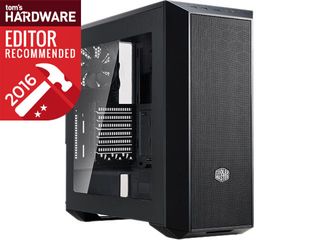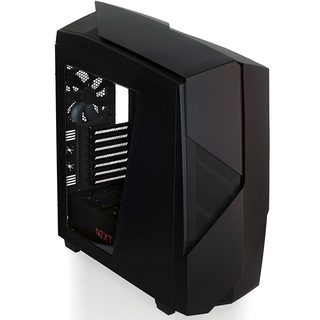Zalman Z9 Neo Mid-Tower ATX Gaming Case Review
Why you can trust Tom's Hardware
Test Results And Conclusion
Before we discuss how our finished build performs, you’ll probably want to see how it looks. Our NH-U12S CPU cooler almost reaches the side panel, which is a good look even though it means that builders have little more than Zalman’s official 160mm cooler height limit.
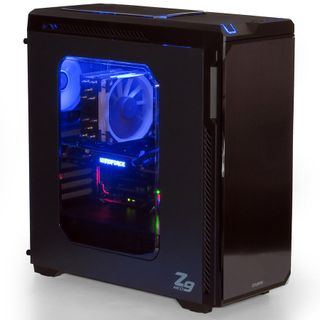
We retain the hardware configuration from previous big cooler reviews to maintain result consistency. Here’s how the Z9 Neo’s specifications compare to other cases in today’s test.
*Shared on 3.5" tray **w/o Center Cage ***By 5.25" Adapter Tray ^Slot 1-4
Test System Components
Software
| Graphics | Nvidia GeForce 347.52 |
|---|---|
| Chipset | Intel INF 9.4.0.1017 |
Benchmark Suite
| Prime95 | v27.9, AVX FFT length 8K, continuous for at least 2 hours |
|---|---|
| RealTemp 3.70 | Maximum Temperature, All Cores Averaged |
| Galaxy CM-140 SPL Meter | Tested at ¼m, corrected to 1m (-12db), dB(A) weighting |
The $140 comparison cases won’t have an easy job in the value comparison, but they are the next-cheapest models in our recent reviews. Perhaps it’s time for us to get a few more “in the middle” review samples.
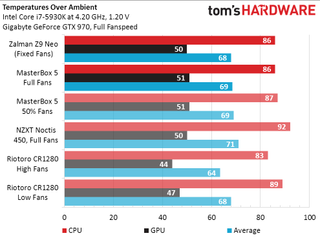
The Z9 Neo has several feature advantages over the MasterBox 5, yet four-pin ATA-style fan power connectors are a major disadvantage since motherboards cannot control the speed. It matches the MasterBox 5’s cooling at full speed, even though it has several additional fans.
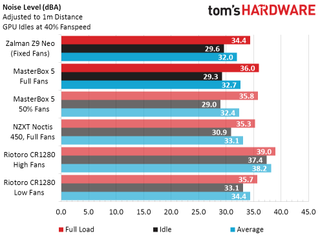
The Z9 Neo does a far better job of isolating full-tilt graphics fan noise than the MasterBox 5. The MasterBox 5 catches up when the graphics fan idles down, appearing to indicate that the Z9 Neo is also stifling the extra noise of its extra fans.
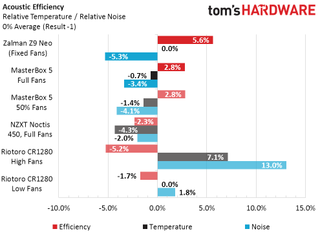
Resetting the average performance to zero percent, we see that the Z9 Neo has a 5.6% better-than-average cooling to noise ratio. The MasterBox 5 was also above average, but only by half that amount.
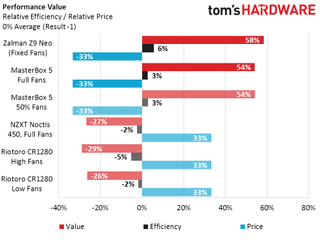
Cooling-to-noise is also a better indicator of overall performance than cooling alone, and Zalman’s advantage there gives the Z9 Neo a 4% value advantage over the same-price MasterBox 5. A look at the balance of features, with dual mid-sized radiator support, extra fans and more ports also tilts the value scale a little into the Z9 Neo’s favor, in spite of its use of ATA-style fan power connections.
MORE: Best Cases
MORE: All Case Content
Stay on the Cutting Edge
Join the experts who read Tom's Hardware for the inside track on enthusiast PC tech news — and have for over 25 years. We'll send breaking news and in-depth reviews of CPUs, GPUs, AI, maker hardware and more straight to your inbox.
-
bit_user Having to access the other side to get at the drives in the bottom tunnel would be annoying. Drives are the component I swap out most frequently, especially when I just went through a round of OS upgrades (Win + Linux), to make backups, copy data, etc.Reply -
10tacle Thanks for this TH team. We can never have enough case reviews! I snapped up an older USB 2.0 variant of the Z9 U3 case a few years ago on NewEgg for $40 on a Shellshocker deal (the one that has the "Z" in the front as part of the intake design where the fan is). I was looking for a second case to place my Sandy Bridge equipment while upgrading to Haswell. It has turned out to be way better than expected in quality.Reply
My only complaint is that the HDD cage inhibits the single 120mm front fan airflow and therefore overall case airflow. That same Sandy build in my Antec Nine Hundred case (running the Haswell upgrade) under load ran about 4C cooler on the CPU, and a whopping 6C cooler on the GTX 680 GPU (blower fan). That shows you how important a good air flow design can really make a difference on air cooled equipment. However, considering I paid $110 originally for the Nine Hundred and no longer overclock the Sandy build, it's not a bad compromise. -
Anathemata I wasn't impressed until I saw the price. This is incredible at the current $60 price tag.Reply
I hope more manufacturers start sporting a divider between PSU and the rest of the computer. It makes cable routing so much easier and looks a whole lot cleaner.
Lastly, the fan filters: I ran my Fractal Define R for over four years without blowing out the inside of the box and there isn't a hint of dust inside. I just vacuum the filters once or twice a year. This has a similar filter placement, and I expect this will perform the same.
Great value.

